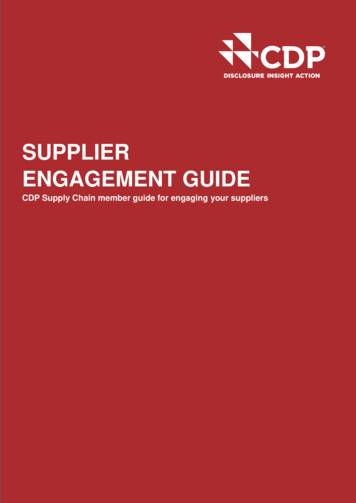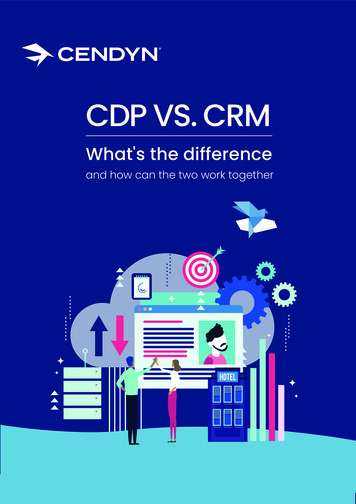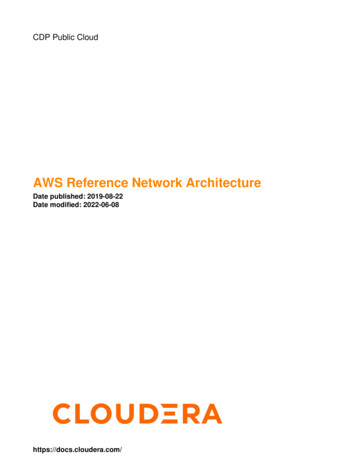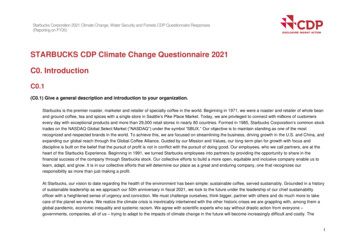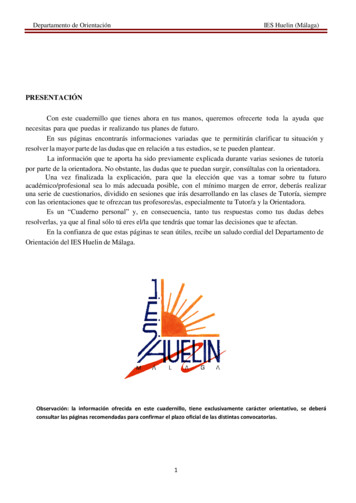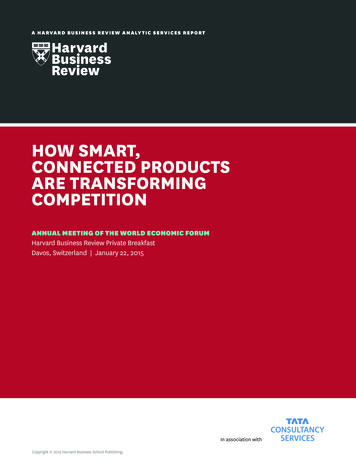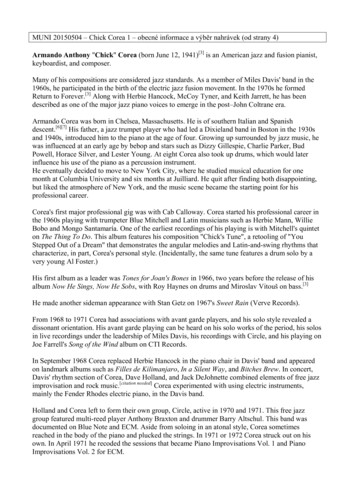![[MS-CDP-Diff]: Connected Devices Platform Protocol Version 3](/img/35/5bms-cdp-5d-220429-diff.jpg)
Transcription
[MS-CDP-Diff]:Connected Devices Platform Protocol Version 3Intellectual Property Rights Notice for Open Specifications Documentation Technical Documentation. Microsoft publishes Open Specifications documentation (“thisdocumentation”) for protocols, file formats, data portability, computer languages, and standardssupport. Additionally, overview documents cover inter-protocol relationships and interactions.Copyrights. This documentation is covered by Microsoft copyrights. Regardless of any otherterms that are contained in the terms of use for the Microsoft website that hosts thisdocumentation, you can make copies of it in order to develop implementations of the technologiesthat are described in this documentation and can distribute portions of it in your implementationsthat use these technologies or in your documentation as necessary to properly document theimplementation. You can also distribute in your implementation, with or without modification, anyschemas, IDLs, or code samples that are included in the documentation. This permission alsoapplies to any documents that are referenced in the Open Specifications documentation.No Trade Secrets. Microsoft does not claim any trade secret rights in this documentation.Patents. Microsoft has patents that might cover your implementations of the technologiesdescribed in the Open Specifications documentation. Neither this notice nor Microsoft's delivery ofthis documentation grants any licenses under those patents or any other Microsoft patents.However, a given Open Specifications document might be covered by the Microsoft OpenSpecifications Promise or the Microsoft Community Promise. If you would prefer a written license,or if the technologies described in this documentation are not covered by the Open SpecificationsPromise or Community Promise, as applicable, patent licenses are available by contactingiplg@microsoft.com.License Programs. To see all of the protocols in scope under a specific license program and theassociated patents, visit the Patent Map.Trademarks. The names of companies and products contained in this documentation might becovered by trademarks or similar intellectual property rights. This notice does not grant anylicenses under those rights. For a list of Microsoft trademarks, visitwww.microsoft.com/trademarks.Fictitious Names. The example companies, organizations, products, domain names, emailaddresses, logos, people, places, and events that are depicted in this documentation are fictitious.No association with any real company, organization, product, domain name, email address, logo,person, place, or event is intended or should be inferred.Reservation of Rights. All other rights are reserved, and this notice does not grant any rights otherthan as specifically described above, whether by implication, estoppel, or otherwise.Tools. The Open Specifications documentation does not require the use of Microsoft programmingtools or programming environments in order for you to develop an implementation. If you have accessto Microsoft programming tools and environments, you are free to take advantage of them. CertainOpen Specifications documents are intended for use in conjunction with publicly available standardsspecifications and network programming art and, as such, assume that the reader either is familiarwith the aforementioned material or has immediate access to it.Support. For questions and support, please contact dochelp@microsoft.com.1 / 66[MS-CDP-Diff] - v20220429Connected Devices Platform Protocol Version 3Copyright 2022 Microsoft CorporationRelease: April 29, 2022
Revision SummaryDateRevision HistoryRevision ClassComments7/14/20161.0NewReleased new document.3/16/20172.0MajorSignificantly changed the technical content.6/1/20173.0MajorSignificantly changed the technical content.9/12/20184.0MajorSignificantly changed the technical content.6/25/20215.0MajorSignificantly changed the technical content.4/29/20226.0MajorSignificantly changed the technical content.2 / 66[MS-CDP-Diff] - v20220429Connected Devices Platform Protocol Version 3Copyright 2022 Microsoft CorporationRelease: April 29, 2022
Table of Contents1Introduction . 51.1Glossary . 51.2References . 61.2.1(Updated Section) Normative References . 71.2.2Informative References . 71.3Overview . 71.3.1Setup . 71.3.2Discovery . 71.3.3Connection . 81.4Relationship to Other Protocols . 81.5Prerequisites/Preconditions . 81.6Applicability Statement . 81.7Versioning and Capability Negotiation . 81.8Vendor-Extensible Fields . 81.9Standards Assignments. 82Messages . 92.1Transport . 92.2Message Syntax . 92.2.1Namespaces . 92.2.2Common Data Types . 92.2.2.1Headers . 92.2.2.1.1Common Header . 92.2.2.2Discovery Messages . 122.2.2.2.1UDP: Presence Request . 122.2.2.2.2(Updated Section) UDP: Presence Response . 122.2.2.2.3Bluetooth: Advertising Beacon . 142.2.2.3Connection Messages . 162.2.2.3.1Connection Header . 162.2.2.3.2Connection Request . 172.2.2.3.3Connection Response . 182.2.2.3.4Device Authentication Request . 192.2.2.3.5Device Authentication Response . 202.2.2.3.6User-Device Authentication Request . 202.2.2.3.7User-Device Authentication Response . 212.2.2.3.8Authentication Done Request . 212.2.2.3.9Authentication Done Response . 212.2.2.3.10Authentication Failure . 222.2.2.3.11Upgrade Request . 222.2.2.3.12Upgrade Response . 232.2.2.3.13Upgrade Finalization . 242.2.2.3.14Upgrade Finalization Response . 252.2.2.3.15Transport Request . 252.2.2.3.16Transport Confirmation . 252.2.2.3.17Upgrade Failure . 262.2.2.3.18Device Info Message . 262.2.2.3.19Device Info Response Message . 262.2.2.4Session Messages . 262.2.2.4.1Ack Messages . 262.2.2.4.2App Control Messages . 272.2.2.4.2.1Launch Uri Messages . 282.2.2.4.2.2Launch Uri for Target Messages . 292.2.2.4.2.3Launch Uri Result . 312.2.2.4.2.4App Service Messages . 322.2.2.4.2.5App Services Result. 333 / 66[MS-CDP-Diff] - v20220429Connected Devices Platform Protocol Version 3Copyright 2022 Microsoft CorporationRelease: April 29, 2022
2.32.2.2.4.2.6Get Resource. 332.2.2.4.2.7Get Resource Response . 342.2.2.4.2.8Set Resource . 342.2.2.4.2.9Set Resource Response. 35Directory Service Schema Elements . 353Protocol Details . 363.1Peer Details . 363.1.1Abstract Data Model . 363.1.1.1CDP Service . 363.1.1.2Discovery Object . 363.1.1.3Connection Manager Object . 373.1.1.4Session Object. 383.1.2Timers . 383.1.3Initialization . 393.1.3.1Encryption . 393.1.3.1.1Encryption Example . 403.1.4Higher-Layer Triggered Events . 453.1.5Message Processing Events and Sequencing Rules . 453.1.5.1Discovery . 453.1.5.2Connection . 453.1.5.3Session . 463.1.6Timer Events . 463.1.7Other Local Events . 464Protocol Examples . 474.1Discovery . 474.1.1Discovery Presence Request . 474.1.2Discovery Presence Response . 484.2Connection . 494.2.1Connection Request . 494.2.2Connection Response . 514.2.3Device Authentication Request . 524.2.4Device Authentication Response . 544.2.5User Device Authentication Request . 554.2.6User Device Authentication Response . 574.2.7Authentication Done Request . 584.2.8Authentication Done Response . 595Security . 615.1Security Considerations for Implementers . 615.2Index of Security Parameters . 616(Updated Section) Appendix A: Product Behavior. 627Change Tracking . 638Index . 644 / 66[MS-CDP-Diff] - v20220429Connected Devices Platform Protocol Version 3Copyright 2022 Microsoft CorporationRelease: April 29, 2022
1IntroductionThe Connected Devices Platform Service Protocol provides a way for devices such as PC's andsmartphones to discover and send messages between each other. It provides a transport-agnosticmeans of building connections among all of a user's devices and allows them to communicate over asecure protocol. There are multiple ways for users to authenticate and when authentication issuccessful, the two devices can communicate over any available transport.Sections 1.5, 1.8, 1.9, 2, and 3 of this specification are normative. All other sections and examples inthis specification are informative.1.1GlossaryThis document uses the following terms:Advanced Encryption Standard (AES): A block cipher that supersedes the Data EncryptionStandard (DES). AES can be used to protect electronic data. The AES algorithm can be used toencrypt (encipher) and decrypt (decipher) information. Encryption converts data to anunintelligible form called ciphertext; decrypting the ciphertext converts the data back into itsoriginal form, called plaintext. AES is used in symmetric-key cryptography, meaning that thesame key is used for the encryption and decryption operations. It is also a block cipher,meaning that it operates on fixed-size blocks of plaintext and ciphertext, and requires the size ofthe plaintext as well as the ciphertext to be an exact multiple of this block size. AES is alsoknown as the Rijndael symmetric encryption algorithm [FIPS197].authentication: The ability of one entity to determine the identity of another entity.base64 encoding: A binary-to-text encoding scheme whereby an arbitrary sequence of bytes isconverted to a sequence of printable ASCII characters, as described in [RFC4648].Beacon: A management frame that contains all of the information required to connect to anetwork. In a WLAN, Beacon frames are periodically transmitted to announce the presence ofthe network.big-endian: Multiple-byte values that are byte-ordered with the most significant byte stored in thememory location with the lowest address.Bluetooth (BT): A wireless technology standard which is managed by the Bluetooth SpecialInterest Group and that is used for exchanging data over short distances between mobile andfixed devices.Bluetooth Low Energy (BLE): A low energy version of Bluetooth that was added with Bluetooth4.0 to enable short burst, short range communication that preserves power but allows proximaldevices to communicate.cipher block chaining (CBC): A method of encrypting multiple blocks of plaintext with a blockcipher such that each ciphertext block is dependent on all previously processed plaintext blocks.In the CBC mode of operation, the first block of plaintext is XOR'd with an Initialization Vector(IV). Each subsequent block of plaintext is XOR'd with the previously generated ciphertext blockbefore encryption with the underlying block cipher. To prevent certain attacks, the IV must beunpredictable, and no IV should be used more than once with the same key. CBC is specified in[SP800-38A] section 6.2.encryption: In cryptography, the process of obscuring information to make it unreadable withoutspecial knowledge.Hash-based Message Authentication Code (HMAC): A mechanism for message authenticationusing cryptographic hash functions. HMAC can be used with any iterative cryptographic hash5 / 66[MS-CDP-Diff] - v20220429Connected Devices Platform Protocol Version 3Copyright 2022 Microsoft CorporationRelease: April 29, 2022
function (for example, MD5 and SHA-1) in combination with a secret shared key. Thecryptographic strength of HMAC depends on the properties of the underlying hash function.initialization vector: A data block that some modes of the AES cipher block operation require asan additional initial data input. For more information, see [SP800-38A].key: In cryptography, a generic term used to refer to cryptographic data that is used to initialize acryptographic algorithm. Keys are also sometimes referred to as keying material.Microsoft Account: A credential for Windows devices and Microsoft services used to sign in usersand connect all of their Microsoft-related products.private key: One of a pair of keys used in public-key cryptography. The private key is kept secretand is used to decrypt data that has been encrypted with the corresponding public key. For anintroduction to this concept, see [CRYPTO] section 1.8 and [IEEE1363] section 3.1.public key: One of a pair of keys used in public-key cryptography. The public key is distributedfreely and published as part of a digital certificate. For an introduction to this concept, see[CRYPTO] section 1.8 and [IEEE1363] section 3.1.salt: An additional random quantity, specified as input to an encryption function that is used toincrease the strength of the encryption.session key: A relatively short-lived symmetric key (a cryptographic key negotiated by the clientand the server based on a shared secret). A session key's lifespan is bounded by the session towhich it is associated. A session key has to be strong enough to withstand cryptanalysis for thelifespan of the session.SHA-256: An algorithm that generates a 256-bit hash value from an arbitrary amount of inputdata.TCP/IP: A set of networking protocols that is widely used on the Internet and providescommunications across interconnected networks of computers with diverse hardwarearchitectures and various operating systems. It includes standards for how computerscommunicate and conventions for connecting networks and routing traffic.Uniform Resource Identifier (URI): A string that identifies a resource. The URI is an addressingmechanism defined in Internet Engineering Task Force (IETF) Uniform Resource Identifier (URI):Generic Syntax [RFC3986].User Datagram Protocol (UDP): The connectionless protocol within TCP/IP that corresponds tothe transport layer in the ISO/OSI reference model.UTF-8: A byte-oriented standard for encoding Unicode characters, defined in the Unicode standard.Unless specified otherwise, this term refers to the UTF-8 encoding form specified in[UNICODE5.0.0/2007] section 3.9.web service: A service offered by a server to other devices, to allow communication over the web.MAY, SHOULD, MUST, SHOULD NOT, MUST NOT: These terms (in all caps) are used as definedin [RFC2119]. All statements of optional behavior use either MAY, SHOULD, or SHOULD NOT.1.2ReferencesLinks to a document in the Microsoft Open Specifications library point to the correct section in themost recently published version of the referenced document. However, because individual documentsin the library are not updated at the same time, the section numbers in the documents may notmatch. You can confirm the correct section numbering by checking the Errata.6 / 66[MS-CDP-Diff] - v20220429Connected Devices Platform Protocol Version 3Copyright 2022 Microsoft CorporationRelease: April 29, 2022
1.2.1 (Updated Section) Normative ReferencesWe conduct frequent surveys of the normative references to assure their continued availability. If youhave any issue with finding a normative reference, please contact dochelp@microsoft.com. We willassist you in finding the relevant information.[MS-DTYP] Microsoft Corporation, "Windows Data Types".[RFC2119] Bradner, S., "Key words for use in RFCs to Indicate Requirement Levels", BCP 14, RFC2119, March 1997, 1.2.2 Informative ReferencesNone.1.3OverviewWith multiple possible transports for Connected Devices Platform V3 service, the protocol defines thediscovery system to authenticate and verify users and devices as well as the message exchangebetween two devices. There will be user-intent to initiate discovery – where a device will listen tobroadcasts and authorize device. This device becomes a client in our architecture and the discovereddevice becomes the host. When a connection is authorized, a transport channel is created between theclient and host so that clients can start exchanging messages with the host.Clients can launch URIs and build app services connections between hosts. The following diagramprovides an overview of the app communication channels between two devices running the ConnectedApps & Devices Platform.Figure 1: Proximal Communication over CDP ProtocolLaunch and Messaging between two devices can occur over proximal connections. Device B (target)acts as the host for the Launch or App Service which can accept incoming client connections fromWindows, Android, or iOS devices (source).1.3.1 SetupPrior to CDP being used, each device sets up a key-pair to secure communications. A key-pair is theassociation of a public key and its corresponding private key when used in cryptography.1.3.2 DiscoveryAs described earlier, a client first sends a presence request to the network via broadcast and multicastand starts listening over Bluetooth Low Energy (BLE). This can include parameters and properties toany host that receives the broadcast, which the host can use to evaluate whether to respond. Theclient then receives unicast responses and can generate the list of available devices. In terms of BLE,devices are constantly advertising a thumbprint that a listener can understand.7 / 66[MS-CDP-Diff] - v20220429Connected Devices Platform Protocol Version 3Copyright 2022 Microsoft CorporationRelease: April 29, 2022
1.3.3 ConnectionAfter a device is discovered, the client sends a protocol message to verify that the protocol issupported between both devices. The client derives a session key and a public key and sends aconnection request. The host receives this request and derives the session key before responding.Finally, the client initiates authorization– the server provides authorization schemes and the clientconstructs the payload and completes the challenge. The server returns the pairing state and thendevices are connected for launch and message exchange.1.4Relationship to Other ProtocolsNone.1.5Prerequisites/PreconditionsPeers have to be able to communicate with one of our web services in order to obtain informationabout other devices singed in with the same Microsoft Account. In order to fully establish a channelwith this protocol, two devices have to be signed-in with the same Microsoft Account. This is arestriction that can be later loosened within the protocol’s implementation.1.6Applicability StatementThe Connected Devices Platform Service Protocol provides a way for devices such as PCs andsmartphones to discover and send messages between each other. It provides a transport-agnosticmeans of building connections among all of a user's devices, whether available through availabletransports.1.7Versioning and Capability NegotiationThis document is focused on the third version of the protocol (V3)—the protocol version is contained inthe header of the messages.1.8Vendor-Extensible FieldsNone.1.9Standards AssignmentsNone8 / 66[MS-CDP-Diff] - v20220429Connected Devices Platform Protocol Version 3Copyright 2022 Microsoft CorporationRelease: April 29, 2022
2Messages2.1TransportAs stated earlier in this document, this protocol can be used for multiple transports. A specifictransport is not defined for these messages. Bluetooth Low Energy (BLE), Bluetooth, and LAN are allcurrently supported.However, the general requirements for a transport are as follows:The transport MUST be able to provide the size of each message, independently of its payload,to the component that implements the protocol. Messages are sent and received over thetransport on ports that are analogous to ports in TCP/IP. Well-known ports allow two peers toestablish initial communication. 2.2Message Syntax2.2.1 NamespacesNone.2.2.2 Common Data TypesThe data types in the following sections are as specified in [MS-DTYP].2.2.2.1 HeadersThe methods in this protocol use the following headers as part of the information exchanged, prior toany requests or responses that are included in the exchange.2.2.2.1.1 Common HeaderEach channel is responsible for defining its own inner protocol and message types.Message deserialization is split into two phases. The first phase consists of parsing the header,validating authenticity, deduping, and decryption. The inner buffer is sent to the owner to manage thesecond part of the unt9 / 66[MS-CDP-Diff] - v20220429Connected Devices Platform Protocol Version 3Copyright 2022 Microsoft CorporationRelease: April 29, 2022
SessionID.ChannelID.Next HeaderNext Header SizePayload (variable).HMAC (variable).Signature (2 bytes): Fixed signature, which is always 0x3030 (0011 0000 0011 0000 binary).MessageLength (2 bytes): Entire message length in bytes including signature.Version (1 byte): Protocol version the sender is using. For this protocol version, this value is always3. Lower values indicate older versions of the protocol not covered by this document.MessageType (1 byte): Indicates current message ession5Ack10 / 66[MS-CDP-Diff] - v20220429Connected Devices Platform Protocol Version 3Copyright 2022 Microsoft CorporationRelease: April 29, 2022
MessageFlags (2 bytes): A value describing the message properties.ValueMeaningShouldAckThe caller expects ACK to be sent back to confirm thatthe message has been received.0x0001HasHMACThe message contains a hashed messageauthentication code which will be validated by thereceiver. If not set, the HMAC field is not present. See“HMAC” below.0x0002SessionEncrypted0x0004If true, indicates that the message is encrypted at thesession level. This is false for non-session messages(which don’t require encryption/decryption).WakeTarget0x0008If true, indicates whether the remote application shouldbe woken up. 1 SequenceNumber (4 bytes): Current message number for this session.RequestID (8 bytes): A monotonically increasing number, generated on the sending side, thatuniquely identifies the message. It can then be used to correlate response messages to theircorresponding request messages.FragmentIndex (2 bytes): Current fragment for current message.FragmentCount (2 bytes): Number of total fragments for current message.SessionID (8 bytes): ID representing the session.ChannelID (8 bytes): Zero if the SessionID is zero.Next Header (1 byte): If an additional header record is included, this value indicates the type. Somevalues are implementation-specific. 2 ValueMeaning0No more headers.1ReplyTold. If included, the payload would contain a NextHeader Size-sized ID of the message to which this messageresponds.2Correlation vector. A uniquely identifiable payload meant toidentify communication over devices.11 / 66[MS-CDP-Diff] - v20220429Connected Devices Platform Protocol Version 3Copyright 2022 Microsoft CorporationRelease: April 29, 2022
ValueMeaning3Watermark ID. Identifies the last seen message that bothparticipants can agree upon.Next Header Size (1 byte): Amount of data in the next header record (so clients can skip).Payload (variabl
memory location with the lowest address. Bluetooth (BT): A wireless technology standard which is managed by the Bluetooth Special Interest Group and that is used for exchanging data over short distances between mobile and fixed devices. Bluetooth Low Energy (BLE): A low energy version of Bluetooth that was added with Bluetooth
